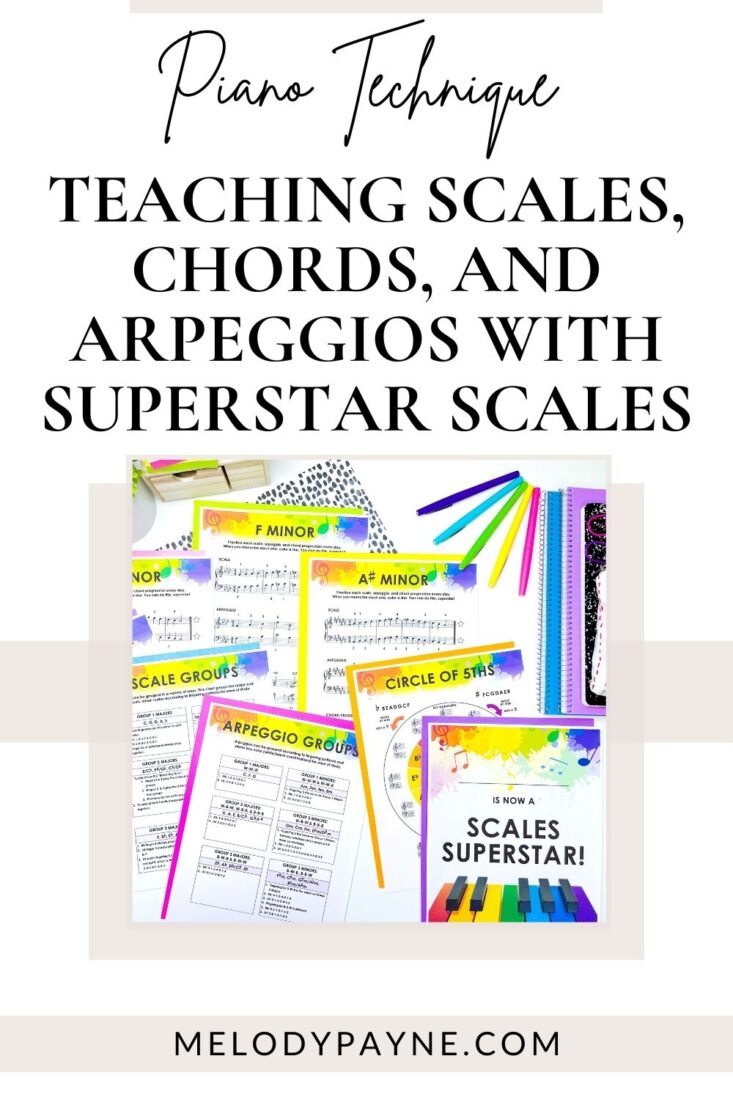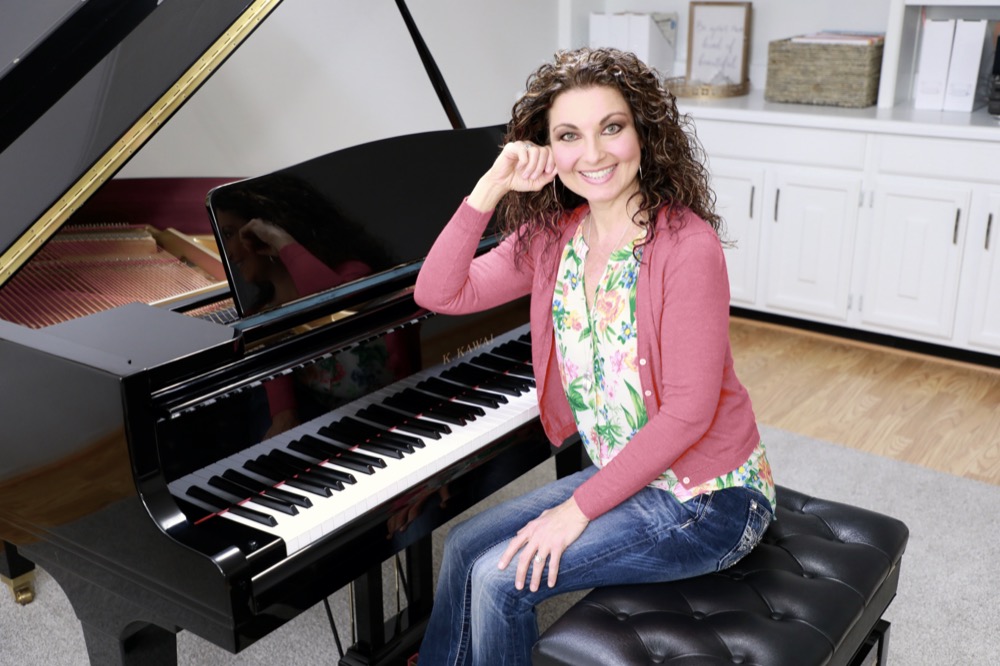Teaching Scales, Chords, and Arpeggios Using the Superstar Scales Piano Technique Book
This post may contain affiliate links. If you purchase something through an affiliate link, I will receive a small commission at no cost to you. For more information, read the disclosure statement here.

What I Like About the Superstar Scales Piano Technique Book
This is my favorite resource for teaching scales, chords, and arpeggios.
Perfect Font Size
How the material is presented on the page affects the student’s perceptions about the task at hand and how they approach it. I have found that students who are accustomed to large, exaggerated font have a harder time transitioning to standard print repertoire. This technique book is clean, uncluttered, with just the right font sizing, suitable for students of all ages.
Scales & Arpeggios
Only necessary fingerings are included. Students learn the alternate fingerings which makes it easier to transition to two, then four- octave scales. Once students understand how to construct a scale using whole and half steps, there is no need for additional scale books.
Chords
This piano technique book focuses on primary chord progressions, rather than all the inversions. Giving students just the right amount of information at the time they need it is important for maintaining a sense of incremental progress and continuity.
Once students master chord progressions in all keys, they can use the theory they have learned to work out the inversions without the need for an additional book.
Separate Printer-Friendly and Colorful Version
For the cost of approximately three scale books, you can purchase the Superstar Scales piano technique book once and never have to purchase any more scale books for your students – if that’s what you want. It’s simpler when students have less books to lug around with all reference sheets in their piano binder.
Practice Ideas for Learning Scales, Chords, and Arpeggios
1. Student Circles Sharps and Flats.
I have found that for many students, a thorough understanding of key signatures happens over time. The process includes developing a vocabulary of musical terms and encountering the theory within the music they are playing.
Marking the sharps and flats helps eliminate any barriers, so students can focus on learning by “doing”. Young students enjoy engaging with the resource by circling notes in their favorite color.
2. Check for Accurate Memory
Even if a scale is taught by rote, I make sure that students can easily track the note on the page as needed. Students memorize each hand separately prior to learning and memorizing the scale hands together.
3. 4-Note Pattern Exercise for Isolating Difficulties
This exercise can be introduced as a preparatory exercise or learned in tandem with the scale.
C Major:
Right Hand Exercises
C D E F E D (x3) C
1 2 3 1 3 2 1
G F E D E F (x3) G
2 1 3 2 3 1 2
Left Hand Exercises
C B A G A B (x3) C
1 2 3 1 3 2 1
E F G A G F (x3) E
3 2 1 3 1 2 3
4. Practice Scales and Arpeggios in Different Groupings
To maintain flow, students should work towards playing each scale going up and down without stopping, and without repeating the top note. Then, scales can be practiced in two, three, and four-note groupings by placing a slight accent on the first note of each grouping.
Arpeggios can be practiced in groups of two or three notes.
5. Preparation for Encountering Scales and Arpeggios within Piano Literature
-Quarter note for the bottom and top notes, and 8th notes for all the notes in-between
-Dotted rhythm
-Staccato
-Slow and legato
-Fast and legato
-Dolce
-Pianissimo
-In contrary motion
-A 3rd apart: RH starts alone, LH starts when RH gets to 3rd note. (LH plays: Do, Re, Mi, Fa, So, La, So, Fa, Mi, Re, Do). Then switch parts and follow the same procedure.
6. With Backing Tracks
Practicing with a backing track is a fun way to add variety. Here is a review of the MusiClock App. Students can also learn to improvise using the app. For students just starting out with improvisation, it may be helpful to limit note choices to the first three notes of the scale prior to moving on to five notes, etc.
“Why Do I Have to Learn Scales and Arpeggios?”
This is a valid question. Learning scales, chords, and arpeggios in 24 keys is tedious work. We can use this opportunity to showcase piano literature in each key via listening activities during the lesson.
A (Small) Sampling of Piano Literature
Below are some great compositions with links to performances by reputable pianists. You can find linked articles (click on a key) written by Jeffrey Freymann (Host of Classical KDFC “The State of the Arts”). This is a wonderful teaching resource as students are unlikely to be familiar with the different characteristics associated with each key.
C– 3rd movement of the “Waldstein Sonata” by Beethoven
c– Fantasia by J.S. Bach
Db– “Des Abends” from Fantasiestucke, Op. 12 by Schumann
c#- 3rd movement of the “Moonlight” Sonata by Beethoven
D- “Folk Dance” from 10 Pieces from Romeo and Juliet, Op. 75 by Prokofiev
d- Variations Serieuses by Mendelssohn
Eb– Piano Concerto No. 1 by Liszt
eb- Toccata by Khachaturian
E- Rhapsody in Blue by George Gershwin
e- Nocturne in E minor, Op. 72 No. 1 by Chopin
F- Sonata in F Major, K. 332 by Mozart
f- “In der Nacht” from Fantasiestucke, Op. 12 by Schumann
Gb- “Black Keys Etude” Op. 10 No. 5 by Chopin
f#- 1st movement of Sonatine by Ravel
G– French Suite No. 5 in G Major by J.S. Bach
g- Prelude Op. 23 No. 5 in G minor by Rachmaninoff
Ab- “Harp” Etude” Op. 25 No. 1 by Chopin
g#- Piano Sonata No. 2 by Scriabin
A– Sonata in A Major, D. 664 by Schubert
a- Barcarolle No. 1 in A Minor, Op. 26 by Faure
Bb- Impromptu in B Flat Major, Op. 142 No. 3 by Schubert
bb- Piano Sonata No. 2 “Funeral March” by Chopin
B- Ballade Op. 10 No. 4 by Brahms
b- Prélude, Choral et Fugue, FWV 21 by Franck
Listening Activities for Developing the Ear
Students benefit from having something to listen for during the listening activity. Here is a starter list of questions that can be adapted to meet the age and stage of the student:
1) What is the mood of this section?
2) What word would you use to describe each movement?
3) Count every time you hear a scale passage.
4) What is the time signature of this piece?
5) Count how many modulations you hear.
6) Write out the structure of this piece as you listen to it.
Check out the Superstar Scales Piano Technique Book if you are looking for a one-stop resource for teaching scales, chords, and arpeggios. First Steps to Superstar Scales and Junior Superstar Scales are also fantastic resources if students are not ready for Superstar Scales just yet.
Read more blog posts about reviewing techniques & theory with your piano students
Don't miss out!
Follow on Facebook and Instagram, join the best Facebook group for piano teachers, and subscribe to the newsletter to get helpful teaching tips, resources, and tutorials delivered straight to your inbox every week.
Michelle Madasamy
Michelle Madasamy
Welcome!

Hi! I’m Melody Payne, a pianist and piano teacher, educational resource author, a fun-loving wife to the most wonderful and talented hubby I could ask for, and a lifelong learner who loves to share. I want to make your life as a music teacher easier by writing and sharing helpful and relevant music teaching articles, and by creating educational resources with your very own students in mind. If you are a parent who wants to enroll your child in piano lessons, I’d love for us to get started building those skills that can give your child a lifetime of musical enjoyment!





